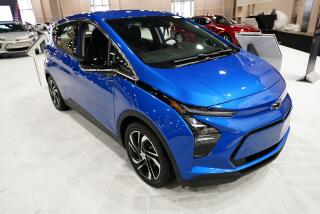3 of 4 Small SUVs Are Rated ‘Poor’ for Crash Repair
- Share via
Buyers of small sport utility vehicles trade roominess and power for price, but they don’t get much of a price break when it comes to the cost of repairing low-speed crash damage, the Insurance Institute for Highway Safety found in a recent series of tests.
The insurance industry-funded research group says the tests, which mimic the kinds of collisions that typically occur in parking lots, aren’t designed to test vehicle safety and reflect only auto makers’ ability to build bumpers that protect against damage that would require expensive body work.
A vehicle’s performance in a low-speed test can foreshadow insurance premium costs, with those that sustain high levels of damage and big repair bills typically subject to higher premiums.
The most recent low-speed tests pitted the 2002 models of the Honda CRV, Land Rover Freelander and Saturn VUE and the redesigned 2003 Subaru Forester against a series of poles and barriers.
Separately, the institute released high-speed test results for the same vehicles Tuesday (see full story in today’s Business section). All but the Freelander received “good” ratings for occupant safety. The small Land Rover was rated a notch down at “acceptable.”
In the low-speed tests, the Subaru received the only “good” rating in the bunch; the others were rated “poor,” with the Honda and Land Rover at the bottom.
In previous tests, the 1998 version of the Subaru Forester received a “marginal” rating, while the ’98 Honda CRV was rated “poor.” The other two vehicles are new and no previous tests exist. Damage back then in the series of four crashes totaled $3,534 on the Honda and $2,337 on the Subaru.
This time around, the redesigned Honda sustained a total of $6,607 in damage, while repair costs for the new Subaru fell to $1,421.
“Subaru is working to improve the bumpers on its vehicles,” said Adrian Lund, the insurance institute’s chief operating officer. The company also is paying attention to repair costs and, after reviewing the institute tests, agreed to change the way it sells bumper repair kits to body shops in order to lower repair costs, Lund said.
The company had intended to sell a rear bumper bar and mounting brackets as a kit for $199, he said. But after the tests revealed that not all three parts are damaged in a low-speed crash, Subaru agreed to “unbundle” the parts so shops that needed only to replace the brackets could buy them separately, at just $18 apiece.
“This is what all manufacturers should do,” Lund said. “Improve bumper designs and reduce the cost of fixing the damage that does occur.”
The institute tests vehicles in the low-speed crashes by propelling them at 5 mph into a flat barrier, from front and rear, and from the front into a metal pole and an angled barrier.
In second place behind the Subaru for total damage was Saturn’s VUE, with a repair estimate from the four crashes of $3,389; the Land Rover Freelander racked up total repair costs of $6,470.
The biggest repair bills for the Land Rover and the Honda were sustained in the rear crashes. A big reason is that both have spare tires mounted on the outside of their rear tailgates. The tires extend out beyond the bumpers, so they get the full impact of any crash and transmit the force into the tailgate, effectively negating the rear bumper’s usefulness.
The external spare “essentially serves as the bumper,” Lund said. “And it doesn’t bump very well.”
Car makers whose vehicles do well in such tests often use the results in advertising campaigns; those whose cars and trucks do poorly routinely say they design their vehicles for occupant safety, not merely to minimize crash repair costs.






